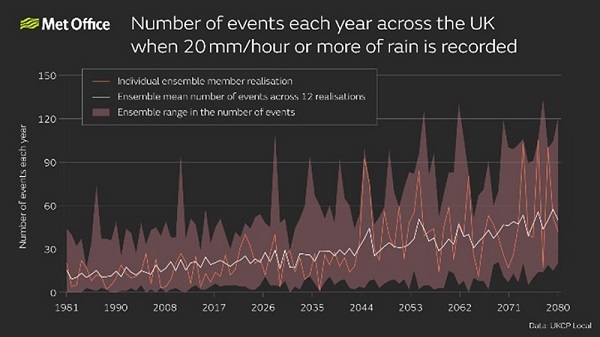Sewers in cities across the globe are struggling to cope with the rapidly changing climate. In July 2023, New York suffered some of the most intense rainfall in its history (opens a new window), while in 2021, London was hit with two flash floods (opens a new window) just two weeks apart which cost insurers tens of millions of pounds in claims. As more frequent storms overload old, often poorly maintained drainage systems, basement properties are under increasing threat.
Urban areas face basement flood risk
While flooding is a threat facing cities worldwide, London is particularly vulnerable. In part, this is due to an ever-growing number of basement developments – a popular choice for owners looking to expand despite a lack of available space. Across the 10 years between 2009 to 2019, the capital saw the construction of more than 7,000 basement additions (opens a new window). These are typically used to add luxury amenities such as cinema rooms, swimming pools, car parks, gyms, and entire apartments for residential use. Although basements can be effective for those seeking to add value to their properties, these constructions also serve to reduce the effectiveness of natural drainage channels.
London’s antiquated sewage system further compounds the likelihood of a severe flood event. The current system dates back to 1865, and has the capacity to cope with the needs of up to 4.5 million people plus rainwater. However, today’s London has a population closer to 9 million, causing the system to overflow around 60 times a year.
These issues are set to intensify amid an ever-changing climate. The UK’s Met Office predicts that extreme rainfall events could be four times as frequent by 2080 compared to the 1980s.

Source: Met Office (opens a new window)
Implications for landlords and property owners
For property owners, the risk of a flood event can have significant consequences. Basements are inherently prone to flooding owing to their position beneath ground level. In London, where properties are typically built and furnished to a high-specification, floods can therefore lead to significant material damage costs to the building and its contents.
Electrical plants, when housed within basement or lower-ground locations, may also be compromised due to a flood event. This raises the possibility that an entire building could face disruption from a single period of heavy rainfall or flood. Resulting displacement may require insurers to find alternative accommodation (opens a new window) for residents, often in costly local hotels – an expenditure that may need to be sustained for the entire duration of any repairs.
These risks can make it a challenge to obtain flood cover with reasonable excesses, or in some instances, any flood coverage at all for owners, landlords or managing agents to secure insurance for properties in high-risk areas.
The importance of risk mitigation
Given the challenges facing high-risk properties, effective risk management can help to avoid significant damage from flood events.
In one recent case, heavy rainfall caused flood damage to the basement of a unit that was close to reaching completion. Although a flood valve was fitted to the main sewer connection which closed correctly during the event, it also prevented the sewer back-charging. This meant that the rainwater had nowhere to drain, thereby overloading the system and forcing basement maintenance holes to lift and flood.
To address the flood risk in the property, a system of pumps was installed in the last chamber before connecting to the main sewer, in addition to new high-level pressurised pipework. This ensured that any future flooding would be pumped back out of the building to the main surface water drain. In effect, this acts to remove the water until the flooding subsides and the main sewer valve reopens.
Other measures to ensure basement owners are prepared for any flooding include:
Checking the area’s flood risk – assessing the flood risk for the area provides as much knowledge as possible, regardless of how long the owner has been in possession of the property
Property protection – for example, moving more valuable equipment to higher floors, regularly carrying out data back-ups, elevating plug sockets, and installing non-return valves which prevent the sewers from backing up
Flood plan preparation – seeking as much information helps formulate a flood plan, such as where electricity is cut off, as well as a list of actions in case of an impending flood (e.g. moving stock or computer services)
Executing a climate risk assessment – prepare to maintain business continuity through expert’s knowledge, specifically seeking how to identify the impact of present and future climate change and its impact on any business operating from the basement properties
Insurers continue to review coverage, and often apply increased excesses in higher risk areas. There are products available that can help mitigating these excesses. Furthermore, risk mitigation experts can provide technical advice on prevention measures.
For more information, please visit Lockton’s Real Estate and Construction (opens a new window) page or contact:
Jamie Smith, Assistant Vice President
E: jamie.smith@lockton.com


